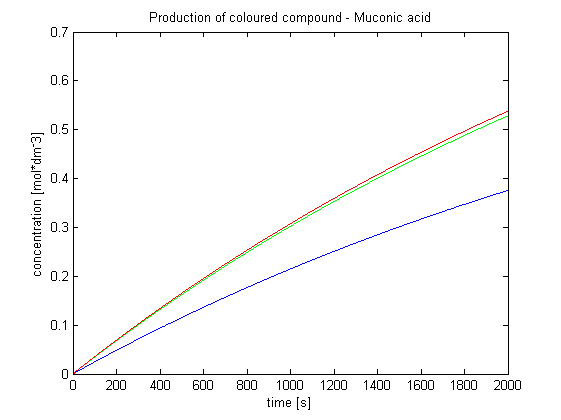Output Amplification Model
Goals:
This model was mainly developed in order to determine whether simple production is better than 1- or 2-step amplification. Further goals, contained estimation of the speed of modelled response.
Elements of the system:
- Dioxygenase (blue on diagrams below) is an enzyme that acts on catechol to produce yellow output. In most of our models dioxygenase was treated as an output, actually, as it was found that active dioxygenase acting on catechol produces yellow colour within split second.
- GFP-Dioxygenase fusion protein (GFP is shown green on diagrams). Dioxygenase joined by the linker to GFP was assumed to be inactive.
- TEV protease (yellow on diagrams below) has ability to cleave GFP-Dioxygenase fusion protein, hence, activate the dioxygenase
- Split TEV protease (orange on diagrams below), is an inactive, split form of TEV mounted on coiled coils. It can be activated again by coiled coils being cleaved by another active TEV.

|
| Diagram illustrating simple production of dioxygenase.
|
|

|
| Diagram showing 1 step amplification. TEV enzyme is being simply produced to activate pre-produced inactive dioxygenase.
|
|

|
| Diagram illustrating 2 step amplification. Enzyme is activating enzyme which activates dioxygenase. Both pre-products have same TEV-site, so simply produced TEV is allowed to act directly on dioxygenase too.
|
|
Major assumptions:
- The chemical and enzymatic reactions are modelled according to the Law of Mass Action.
- Model assumes that the modelled system is innert within bacterial body or that reaction with outher species within bacterium is neglible. For example, TEV protease is supposed to be unsuccessful in cleaving other molecules due to its specifity.
Surface Protein Model
Goals:
The aim of this model is to determine the concentration of Schistosoma elastase or TEV protease that should be added to bacteria to trigger the response. That was supposed to allow us to correlate required concentration for the activation with the concentration of Schistosoma elastase in the lake.<
It is also attempted to model how long it takes for the protease or elastase to cleave enough peptides.
Elements of the system:
- Surface protein that consists of cell wall binding domain, linker, AIP (Auto Inducing Peptide)
- Schistosoma elastase (enzyme released by the parasite) cleaves AIP from cell wall binding domain at the linker site. In laboratory we used TEV protease as we could not get handle of Schistosoma elastase.
- ComD receptor is being activated by high enough AIP concentration.
Major assumptions:
- The chemical and enzymatic reactions are modelled according to the Law of Mass Action.
- Model assumes that the modelled system is innert within bacterial body or that reaction with outher species within bacterium is neglible. For example, TEV protease is supposed to be unsuccessful in cleaving other molecules due to its specifity.
- Due to carefully chosen cell concentrations, the diffusion of free AIPs could be neglected. However, that restricts the model to the considered cell concentrations only.
- Receptor activation threshold was defined by 1 specific value as opposed to considering intermediate states between fully "off" and "on".
|
 "
"








